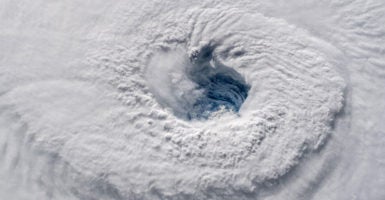Georgia, North Carolina, South Carolina, Virginia, the District of Columbia, and Maryland have all declared states of emergency in preparation for Hurricane Florence.
According to the National Weather Service’s National Hurricane Center, a life-threatening storm surge, catastrophic flash-flooding, and significant river flooding are all likely over portions of the Carolinas and the Mid-Atlantic states from late this week into early next week.
In addition, damaging hurricane-force winds are likely to batter portions of the coasts of the Carolinas, and a hurricane warning is in effect there.
Florence was downgraded to a Category 3 hurricane midday Wednesday after fluctuating as high as a Category 4 multiple times in the past few days.
Meteorologists are predicting the storm will strengthen back to a Category 4 in the coming days before making landfall later this week or over the weekend. Wind gusts topping 100 mph are likely near, and just north of, where Florence approaches the coasts of South Carolina and North Carolina.
Federal Emergency Management Agency Administrator Brock Long warned that “power will be off for weeks.”
“You’re going to be displaced from your home in coastal areas. There will be flooding in the inland areas as well,” he added.
While the exact course of the storm remains uncertain, parts of the Carolinas are estimated to receive up to 40 inches of rain, with parts of surrounding states potentially getting 12 inches.
Cities such as Charleston and Myrtle Beach in South Carolina, and Wilmington, New Bern, and Hatteras in North Carolina are in so-called “storm-surge areas,” which will experience coastal flooding of water coming in from the ocean.
Areas along the coast of the Carolinas directly hit by the storm could experience more than 12 feet of storm surge.
South Carolina Gov. Henry McMaster ordered the state’s entire coastline to be evacuated starting at noon Tuesday. Eastbound lanes of Interstate 26 heading into Charleston and U.S. 501 heading into Myrtle Beach were reversed.
North Carolina Gov. Roy Cooper said his state was “in the bull’s eye” of the storm and urged North Carolinians to “get ready now.”
North Carolina’s coastal areas are under evacuation orders, as are parts of the Virginia coast.
Georgia is the latest to declare a state of emergency, as the storm seems to be shifting to the south.
FEMA estimates that as many as 1 million people would be fleeing the coast. If you are in those areas, please heed the warnings of authorities.
For many people, the challenge could be finding a safe haven. If Florence slows to a crawl just off the coast, it could bring torrential rains to the Appalachian Mountains and as far away as West Virginia, causing flash floods, mudslides, and other smaller-scale disasters.
After the storm passes will be the time for cleaning up and rebuilding. But for now, those in the path of the storm should keep their families safe by taking whatever precautions they can.





























